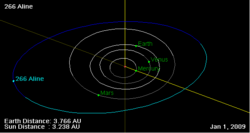Astronomy:266 Aline
 Orbit of Aline | |
| Discovery | |
|---|---|
| Discovered by | Johann Palisa |
| Discovery date | 17 May 1887 |
| Designations | |
| (266) Aline | |
| A887 KA | |
| Minor planet category | Main belt |
| Orbital characteristics[1] | |
| Epoch 31 July 2016 (JD 2457600.5) | |
| Uncertainty parameter 0 | |
| Observation arc | 124.91 yr (45623 d) |
| |{{{apsis}}}|helion}} | 3.24229 astronomical unit|AU (485.040 Gm) |
| |{{{apsis}}}|helion}} | 2.36559 AU (353.887 Gm) |
| 2.80394 AU (419.463 Gm) | |
| Eccentricity | 0.15633 |
| Orbital period | 4.70 yr (1715.0 d) |
| Average Orbital speed | 17.79 km/s |
| Mean anomaly | 53.2036° |
| Mean motion | 0° 12m 35.708s / day |
| Inclination | 13.3989° |
| Longitude of ascending node | 235.904° |
| 150.489° | |
| Physical characteristics | |
| Dimensions | 109.09±2.9 km[1] 107.95 ± 6.62 km[2] |
| Mass | (4.15 ± 0.42) × 1018 kg[2] |
| Mean density | 6.29 ± 1.32 g/cm3[2] |
| Rotation period | 13.018 h (0.5424 d)[1] 13.02 h[3] |
| Geometric albedo | 0.0448±0.003 |
| C | |
| Absolute magnitude (H) | 8.80 |
Aline (minor planet designation: 266 Aline) is a fairly large main belt asteroid that was discovered by Johann Palisa on 17 May 1887 in Vienna and is thought to have been named after the daughter of astronomer Edmund Weiss. It is a dark C-type asteroid and is probably composed of primitive carbonaceous material. 266 Aline is orbiting close to a 5:2 mean motion resonance with Jupiter, which is located at 2.824 astronomical unit|AU.[4]
Photometric observations made in 2012 at the Organ Mesa Observatory in Las Cruces, New Mexico, produced a light curve with a period of 13.018 ± 0.001 hours and a brightness variation of 0.10 ± 0.01 in magnitude.[3]
In 2001, the asteroid was detected by radar from the Arecibo Observatory at a distance of 1.41 AU. The resulting data yielded an effective diameter of 109 ± 15 km.[5]
References
- ↑ 1.0 1.1 1.2 "266 Aline". JPL Small-Body Database. NASA/Jet Propulsion Laboratory. https://ssd.jpl.nasa.gov/sbdb.cgi?sstr=266;cad=1.
- ↑ 2.0 2.1 2.2 Carry, B. (December 2012), "Density of asteroids", Planetary and Space Science 73: pp. 98–118, doi:10.1016/j.pss.2012.03.009, Bibcode: 2012P&SS...73...98C. See Table 1.
- ↑ 3.0 3.1 Pilcher, Frederick (July 2012), "Rotation Period Determinations for 46 Hestia, 223 Rosa, 225 Henrietta, 266 Aline, 750 Oskar, and 765 Mattiaca", The Minor Planet Bulletin 39 (3): pp. 171–173, Bibcode: 2012MPBu...39..171P.
- ↑ Hahn, G. et al. (June 1991), "Orbital evolution studies of asteroids near the 5:2 mean motion resonance with Jupiter", Astronomy and Astrophysics 246 (2): 603–618, Bibcode: 1991A&A...246..603H.
- ↑ Magri, Christopher et al. (January 2007), "A radar survey of main-belt asteroids: Arecibo observations of 55 objects during 1999 2003", Icarus 186 (1): 126–151, doi:10.1016/j.icarus.2006.08.018, Bibcode: 2007Icar..186..126M, http://echo.jpl.nasa.gov/asteroids/MBAs/magri.etal.2007.mbas.pdf, retrieved 2015-04-14.
External links
- The Asteroid Orbital Elements Database
- Minor Planet Discovery Circumstances
- Asteroid Lightcurve Data File
- 266 Aline at AstDyS-2, Asteroids—Dynamic Site
- 266 Aline at the JPL Small-Body Database
 |

